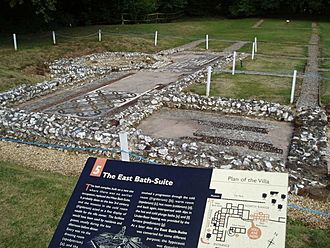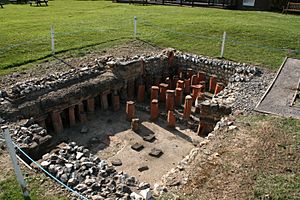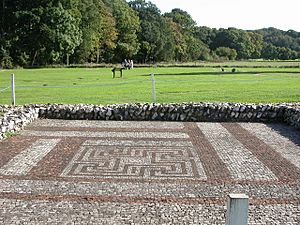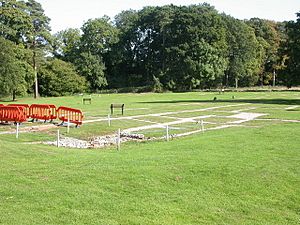Rockbourne Roman Villa facts for kids
Quick facts for kids Rockbourne Roman Villa |
|
|---|---|

Rockbourne Roman Villa - East Bath Suite
|
|
| General information | |
| Type | Roman villa |
| Location | Rockbourne grid reference SU120170 |
| Country | United Kingdom |
| Coordinates | 50°57′11″N 1°49′49″W / 50.9531°N 1.8304°W |
| Construction started | 1st century |
| Demolished | 5th century |
Imagine stepping back in time to a huge Roman country house! That's what the Rockbourne Roman Villa is. It's a large Roman estate that was dug up and is now open for everyone to visit in the village of Rockbourne, Hampshire, England.
This amazing villa was first found by a farmer in 1942. Over the next thirty years, a man named A. T. Morley Hewitt led exciting digs to uncover its secrets. The main part of the villa was a grand house built around a courtyard. It even had fancy Roman mosaic floors and special bath suites. Besides the main house, there were also farm buildings and workshops, showing it was the heart of a big farming area.
The story of Rockbourne Roman Villa began even before the Romans arrived, in the Iron Age. People lived and worked here until the 5th century. Today, you can explore parts of the villa and visit a museum on site. The museum displays many cool items found during the digs, helping you learn all about the villa's long history.
Contents
Discovering Rockbourne Roman Villa
The Rockbourne Roman Villa is located in West Park, close to the village of Rockbourne in Hampshire. It sits about 5 kilometers northwest of the town of Fordingbridge. This villa was once the center of a huge farming estate and is the biggest Roman villa known in this area.
The villa's discovery in 1942 was quite an accident! A farmer was digging for a ferret when he found lots of oyster shells and then a beautiful mosaic floor. Realizing these finds were important, A. T. Morley Hewitt bought the land. He then led archaeological digs every summer from 1956 to 1978.
At first, some of the early digs weren't perfectly recorded. This made it a bit tricky to understand the villa's timeline. However, Hampshire County Council took over the site in 1979. New digs led by I. P. Horsey from 1978 to 1982 helped experts understand the many changes the villa went through during its 400 years of use.
Rockbourne Villa might have been connected to another villa found at Downton, about 8 kilometers away. These two villas might have managed large areas of farmland on either side of the River Avon. Interestingly, pottery kilns were found nearby at Allen's Farm. These kilns made pottery in the late 3rd century and might have been part of the Rockbourne Villa estate.
The Villa's Story Through Time
The First Homes: 1st Century
The very first home on this spot was a timber roundhouse with a chalk floor. This was a common type of house in the Late Iron Age. In the 1st century, this roundhouse was replaced by a small, rectangular stone house. A separate work-hall was also built nearby, set at a right angle to the house.
Growing Bigger: 2nd Century
Around the year 150, the small stone house was taken down to make way for a much larger building. The new house was a "row-house" style, with an important main room and smaller rooms on either side. This new house lined up with the older work-hall, but still stood apart. This was the start of what would become the villa's west wing. Later in the 2nd century, a small bath suite was added to this west house. A cool fact about this bath suite is that its underfloor heating system, called a hypocaust, used curved roof tiles instead of regular bricks for its support stacks!
A Grand Courtyard Villa: 3rd Century
During the 3rd century, more buildings and sections were added, turning Rockbourne into a grand courtyard villa. Around the year 200, a new north wing was built, connecting to the west wing. This north wing might have had a small bath suite at first. Later, a separate, detached bath house was built there. The best-preserved mosaic floors are found in the north wing. These mosaics all feature geometric patterns, though they don't have any pictures of people or animals.
At some point, a south wing was also built. This included a large building with aisles and several workshops. In 1967, an amazing discovery was made: a hoard of 7,717 bronze coins! They were found buried in a pottery jar. These coins were buried around 295 AD. This suggests that the villa might have faced some difficult times, but why the coins were never dug up again remains a mystery.
Peak and Changes: 4th Century
By the 4th century, Rockbourne was a very large courtyard villa, with buildings on at least three sides. There were probably about 40 rooms in use! The house in the north wing was rebuilt during this century. The bath house in the north wing was also updated, but then it seems to have stopped being used. Instead, the bath suite in the west house was made bigger and improved.
The Villa's Decline
By the early 5th century, the villa's good times quickly came to an end. Some of the beautiful mosaics were broken, and simple fireplaces were made on the floors. Holes found from this time might mean people tried to prop up the roofs. More signs of trouble came from another discovery in 1986. Just 3 kilometers from the villa, a hoard of 16 late Roman gold coins was found, dating from 394-395 AD. This suggests people were burying their valuables because times were uncertain. The only adult burials found at the site are from after the Roman period. One person seems to have died when the tiled roof collapsed.
Visiting Rockbourne Roman Villa Today
The original digs from 1956 to 1976 were open to visitors. Today, the site is looked after by Hampshire County Council. Much of the site has been covered back up to protect it from damage.
Many of the cool items found during the excavations are on display at the museum right on the site. Other finds are stored in Winchester. You can see everything from pottery made in the New Forest to pieces of animal bone. Two particularly interesting finds are two damaged Roman milestones. These were found reused in the villa's walls. One is from the time of Emperor Trajan Decius (249-251 AD), and the other from Tetricus II (272 AD). Another major discovery was a rectangular stone table or sideboard decorated with carved patterns.
In 2014, the ownership of Rockbourne Roman Villa was moved to the Hampshire Cultural Trust. This was part of a bigger change where many museums from Hampshire County Council and Winchester City Council joined the Trust.




